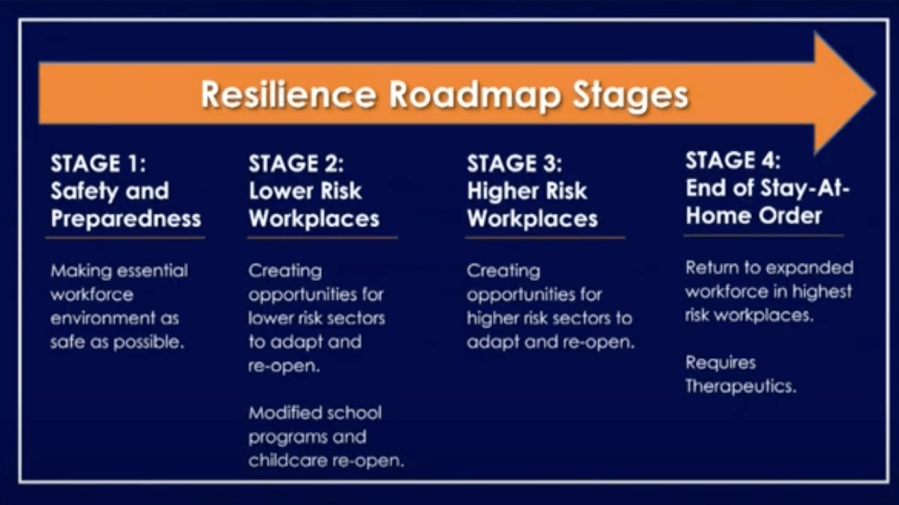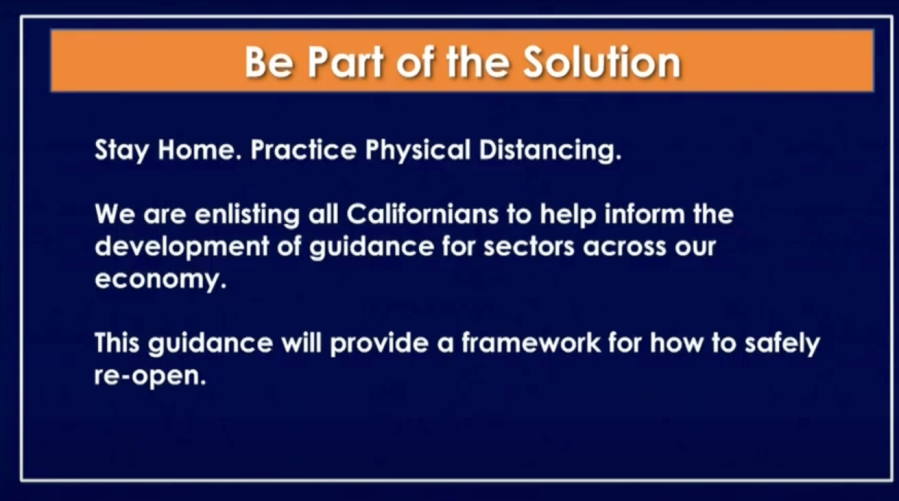Gov. Gavin Newsom on Tuesday announced four different stages for easing California’s stay-at-home orders, saying the state is “weeks” away from making the first changes.
The governor said California’s residents have largely abided by stay-at-home orders and hospitalizations for COVID-19 have remained stable over the past few weeks.
“But we’re still, by no stretch of the imagination, out of the woods,” he said.
If the stability continues, Californians can expect some businesses to reopen soon, according to officials. But they will look different.
The new plan come two weeks after the governor laid out six indicators for lifting the orders. They include benchmarks for expanding the state’s testing capacity, protecting the most vulnerable, addressing hospitals’ needs, working on developing therapeutics and potentially a vaccine and deciding on how physical distancing would look when orders are lifted.
These indicators will help guide when the state can take each step to ease restrictions, according to Newsom.
“Politics will not drive our decision making, protest won’t drive our decision making, political pressure will not drive our decision making. The science, the data, public health will drive our decision making,” the governor said.
The governor warned that even if some restrictions are loosened in the coming weeks, the state needs to be ready to respond in case there’s a spike in infections.
“If we pull back and we modify our stay-at-home too early and we start to see an increase and surge in cases, hospitalizations and spread, then we have to have the ability to toggle back, we have to have the ability to adjust, we have to have the ability to fix it,” Newsom said.
Here are the four stages to gradually reopening the state’s businesses, then eventually, lifting stay-at-home orders:

The current stage
California is now in the first stage of working toward reopening.
That involves ensuring essential businesses are safe, working to ramp up testing and building out contract tracing capabilities.
The state is also trying to make sure hospitals are ready to handle a potential surge in cases and securing protective equipment for essential workers.
To move toward the next stage of reopening some businesses and venues within the next few weeks, governments will have to provide guidance and policies on how workplaces can reduce risk of infection, the state’s public health director Sonia Angell said.
And businesses need to start making changes to workplaces starting now so they’ll be ready to reopen when the state allows it, she said.
Opening up some business, schools and child care centers in the next few weeks
Some nonessential businesses will be allowed to reopen in the coming weeks, but with changes made to prevent the spread of the virus.
Retail stores will be able to do curbside pickups for orders, and manufacturing of nonessential items like toys, clothing and furniture will resume.
Some offices will be allowed to reopen, but those that can keep employees working from home should continue to do so, Angell said.
And also with modifications, the state will allow some parks, trails and other public spaces to open up again.
“Trying to think about how we can modify that to make them safer for individuals to enjoy outdoor spaces because we know physical activity is so important to our health, and this is also about health clearly,” Angell said.
Schools and child care centers can also open if changes are made to make sure students will be safe from contracting the illness.
This can include having the school year start earlier, possibly as early as late July, Newsom said.
People will continue wearing masks and practicing physical distancing as the state transitions through the stages.
California’s counties can choose to relax stricter local orders on their own pace during the next stage of reopening, Angell said.
Opening ‘higher risk’ workplaces will take months
It may be months before Californians can go get their hair or nails done, or visit gyms and entertainment venues, according to officials.
That’s because people usually sit closer together at these venues, making the spread of the coronavirus more likely.
Angell said they will need a lot more modification to make them safe for people to move around in, with lower risk of contracting COVID-19.
While California will take much longer to reopen the “higher risk” venues and businesses, it’s the third step the state is working toward before lifting orders completely.
With modifications made to curb the transmission of COVID-19, venues like movie theaters and beauty parlors could reopen and in-person religious services and weddings will be allowed.
During this phase, sporting events will be allowed but without live audiences, according to Angell.
Lifting stay-at-home orders
Concerts, conventions and sporting events with live audiences will eventually be allowed when all six of Newsom’s indicators are met.
“Without modification necessary at that time, because at that time we will know, that we have identified a way that we can keep people safe from COVID-19, either from population immunity or from vaccinations,” Angell said.
Newsom said California is still “months” away from this stage.
Public health officials and health experts nationwide have emphasized that a coronavirus vaccine is still more than a year away.






















